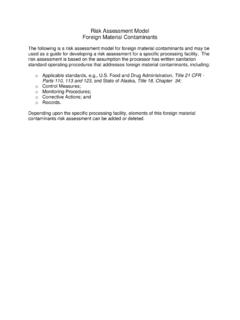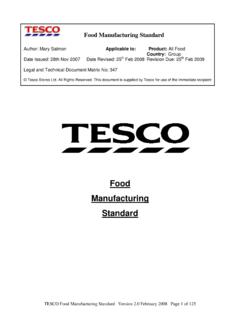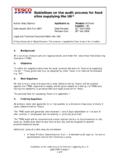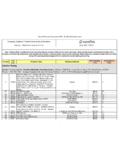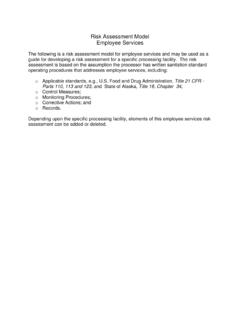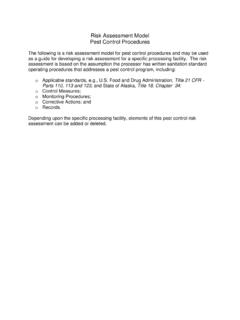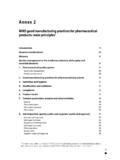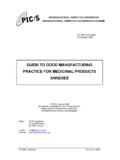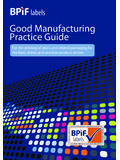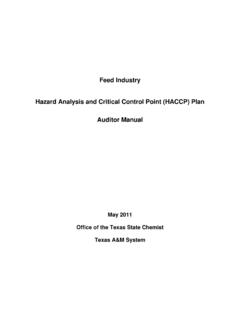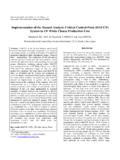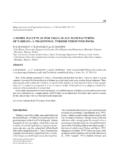Transcription of Training Guidelines for 21 Code of Federal Regulations ...
1 1600 South Jackson Street Seattle, Washington 98144 Phone 206 323 3540 Fax 206 323 3543 SETTING THE STANDARD IN SEAFOOD SAFETY 1 Training Guidelines for 21 Code of Federal Regulations , Part 117 Current good manufacturing Practice, Hazard analysis , and Risk-Based Preventative Controls for Human Food Technical Bulletin O-06 Seafood processors in compliance with 21 CFR Part 123-Seafood HACCP are exempt from 21 CFR Part 117 Subparts C (Hazard analysis and Risk-Based Preventative Controls) and G (Supply Chain Program). However, all seafood processors must comply with Subpart B-Current good manufacturing Practice. Subpart A, Section (a) of the regulation requires management to ensure all individuals who manufacture, process, pack, or hold food subject to Subparts B and F are qualified to perform their assigned duties.
2 Subpart A, Section (b) of the regulation requires all individuals engaged in manufacturing , processing, packing, or holding food (including temporary and seasonal personnel) or in the supervision thereof must: (1) Be a qualified individual who has the education, Training , or experience (or a combination thereof) necessary to manufacture, process, pack, or hold clean and safe food as appropriate to the individual's assigned duties. (2) Receive Training in the principles of food hygiene and food safety, including the importance of employee health and personal hygiene, as appropriate to the food, the facility and the individual s assigned duties. (3) Supervisory personnel responsible for ensuring compliance must have appropriate education, Training or experience (or combination thereof) necessary to supervise the production of clean and safe food.
3 Subpart A, Section (d) of the regulation requires the Training records for Section (b)(2) must be established and documented. The recommended Training for compliance with the regulation should include the following: FOOD: o Food Safety Understanding of risks associated with the food product and/or process. o Employee Health Requirements Symptoms of illness and/or injury that present food safety hazards , , fever, sore throat, vomiting, diarrhea, cuts and/or open wounds. Revision Date: 5-3-16 Supersedes: New 2 cont. Training Guidelines for 21 Code of Federal Regulations , Part 117 Current good manufacturing Practice, Hazard analysis , and Risk-Based Preventative Controls for Human Food o Personal Hygiene Protecting the product from cross-contamination from personnel. No jewelry allowed in processing or storage areas.
4 Hair restraints required around exposed food, equipment and packaging. No eating, drinking or tobacco use in processing or storage areas. Personal hygiene ( , bathing, wearing clean clothes.) Hand washing and hand sanitizing. FACILITY: o Cleanliness of production and storage areas. Documented standard operating procedures for the cleaning of equipment and instructions for chemical use and storage. o Sanitation of production and storage areas. Documented instructions for sanitation chemicals, concentration, proper chemical storage and requirement of a rinse step if appropriate. o Segregation of personal gear/work uniforms. Provision for separate changing areas and personal gear storage areas. o Product flow to minimize risk of cross-contamination. Understanding the need for segregation of raw product (incoming) to finished product (outgoing), especially when there is a kill step involved ( , cooking, pasteurization, etc.)
5 O Segregation of food grade and non-food grade chemicals. STAFF (including contract workers and visitors.): o ALL employees must have GMP Training , including health and hygiene. o ALL supervisors and workers responsible for maintaining food safety must have an understanding of: How to perform their job correctly to meet food safety standards. How their job affects the safety of the food and/or process. o Job duties and Training for supervisors and workers responsible for maintaining food safety: Should match the skill set necessary to perform the job. Understand the food safety risks associated with the product and/or process and what hazards are specific to each individual job/task. o Supervisor Training is needed for overseeing the process and employees to ensure the production of clean and safe food: The workers are trained in their assigned duties.
6 The workers are properly performing the assigned tasks. The workers are meeting the criteria set out. The food is produced in a safe manner. o Re- Training should be performed as often as necessary when deviations occur, at least annually, especially for seasonal operations. 3 cont. Training Guidelines for 21 Code of Federal Regulations , Part 117 Current good manufacturing Practice, Hazard analysis , and Risk-Based Preventative Controls for Human Food Subpart F, Section of the regulation requires the Training records for Section (b)(2) must be reviewed, retained and available to regulatory personnel for a minimum of two years. Training recommendations, at a minimum: Personnel GMP s Health/ HygieneJob Duties* HACCP/ Preventative Controls Sanitation/ Chemical Controls Management X X X X X Office Staff X X X HACCP Team Members X X X X X QA/QC Staff X X X X X CCP Monitoring Personnel X X X X X Supervisors X X X X X Production Personnel X X X Machinists/Mechanics Engineers X X X X Sanitation Staff X X X X Contract Workers X X Other Visitors X X * As necessary depending upon the position.
7 References: 21 CFR Part 117 Current good manufacturing Practice, Hazard analysis , and Risk-Based Preventative Controls for Human Food: Subpart A, Sections (a)(1),(b), (c) and (d) Subpart B Subpart F, Section
